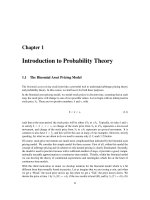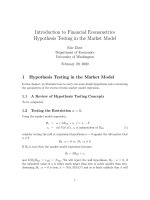introduction to Estimation
Bạn đang xem bản rút gọn của tài liệu. Xem và tải ngay bản đầy đủ của tài liệu tại đây (167.78 KB, 20 trang )
CHAPTER 9
1
ESTIMATION
INTRODUCTION
In almost all realistic situations
parameters are unknown.
2
We will use the sampling distribution to
draw inferences about the unknown
population parameters.
Statistical inference is the process by which we
acquire information and draw conclusions about
populations from samples.
Statistics
Data
Population
Information
Sample
Inference
Statistic
Parameter
There are two procedures for making inferences:
• Estimation.
• Hypotheses testing.
The objective of estimation is to determine the
approximate value of a population parameter on
the basis of a sample statistic.
E.g., the sample mean ( ) is employed to
estimate the population mean ( ).
There are two types of estimators:
Point Estimator
Interval Estimator
A point estimator draws inferences about a
population by estimating the value of an
unknown parameter using a single value or
point.
We saw earlier that point probabilities in
continuous distributions were virtually zero.
5
The probability of the point estimator being
correct is zero.
An interval estimator draws inferences
about a population by estimating the value
of an unknown parameter using an interval.
That is we say (with some ___% certainty)
that the population parameter of interest is
between some lower and upper bounds.
For example, suppose we want to estimate the mean
summer income of a class of business students. For
n = 25 students, is calculated to be 400 $/week.
point estimate
interval estimate
An alternative statement is:
The mean income is between 380 and 420 $/week.
ESTIMATING
WHEN
IS KNOWN…
From Chapter 9, the sampling distribution
of X is approximately normal with mean µ
and standard deviation σ / n
Thus
X −µ
Z=
σ/ n
is (approximately) standard normally
distributed.
From Chapter 8,
P(− Z α / 2 < Z < Z α / 2 ) = 1 − α
Thus, substituting Z produces
x −µ
P(− z α / 2 <
< zα / 2 ) = 1 − α
σ/ n
With a little bit of algebra,
σ
σ
P µ − z α / 2
< x < µ + zα / 2
=1− α
n
n
With a little bit of different algebra we have
σ
σ
P x − z α / 2
< µ < x + zα / 2
=1− α
n
n
The confidence interval
Lower confidence limit (LCL) =
σ
x − zα / 2
n
Upper confidence limit (UCL) =
x + zα / 2
σ
n
The probability 1 – α is the confidence level,
which is a measure of how frequently the
interval will actually include µ.
Four commonly used confidence levels
α
0.10
0.05
0.02
0.01
α/ 2
0.05
0.025
0.01
0.005
zα/
1.645
2
1.96
2.33
2.575
11
Confidence
level
0.90
0.95
0.98
0.99
Example 2: Doll
Computer Comp found
that the demand over the lead time is
normally distributed with a standard
deviation of 75. Estimate the expected
demand
over
x = 370
.16. the lead time at 95%
confidence level. Assume N=25 and
x ± zα 2
σ
n
= 370.16 ± z .025
= 370.16 ± 1.96
75
25
75
25
= 370.16 ± 29.40 = [ 340.76,399.56]
Comparing two confidence intervals with the same
level of confidence, the narrower interval provides
more information than the wider interval
The width of the confidence interval is calculated by
and therefore is affected by
• the population standard deviation (s)
• the confidence level (1-a)
• the sample size (n).
13
σ
σ
σ
x + z α 2
− x − z α 2
= 2Z α / 2
n
n
n
If the standard deviation grows larger, a longer
confidence interval is needed to maintain the
confidence level.
Note what happens when σ increases to 1.5 σ
α/2
α/2
1-α
Confidence level
2z α / 2
n
1.5σ
n
14
2z α / 2
σ
Example 1: Estimate the mean value of the distribution
resulting from the 100 repeated throws of the die. It is
known that σ = 1.71.
Use 90% confidence level:
1.71
σ
= x ± .28
x ± zα 2
= x ± 1.645
100
n
Use 95% confidence level:
15
x ± zα 2
σ
1.71
= x ± 1.96
= x ± .34
n
100
Larger confidence level requires longer confidence
interval
α/2 = 2.5%
α/2 = 5%
90%
95%
Confidence level
2z.05
2z .025
σ
n
σ
n
= 2(1.645)
= 2(1.96)
α/2 = 2.5%
σ
n
σ
n
16
α/2 = 5%
There is an inverse relationship between the width of
the interval and the sample size
Interval width = 2z α / 2
σ
n
17
By increasing the sample size we can decrease
the width of the confidence interval while the
confidence level can remain unchanged.
The phrase “estimate the mean to within
W units”, translates to an interval
estimate of
x ±the
W form
W
zα / 2
σ
n
=
18
where W is the margin of error.
The required sample size to estimate
the mean is
22
19
zzαα 22σσ
nn ==
W
W
Example 4: To estimate the amount of lumber
that can be harvested in a tract of land, the
mean diameter of trees in the tract must be
estimated to within one inch with 99%
confidence. What sample size should be taken
for the margin of error +/-1 inch? (assume
diameters are normally distributed with σ = 6
inches).
The confidence level 99% leads to α = .01,
thus zα/2 = z.005 = 2.575.
2
2
20
z α 2σ
2.575(6)
n=
= 239
=
W
1
![[CEH V3] Introduction to Ethical Hacking](https://media.store123doc.com/images/document/13/ly/ap/medium_3ABUW8WdDH.jpg)








